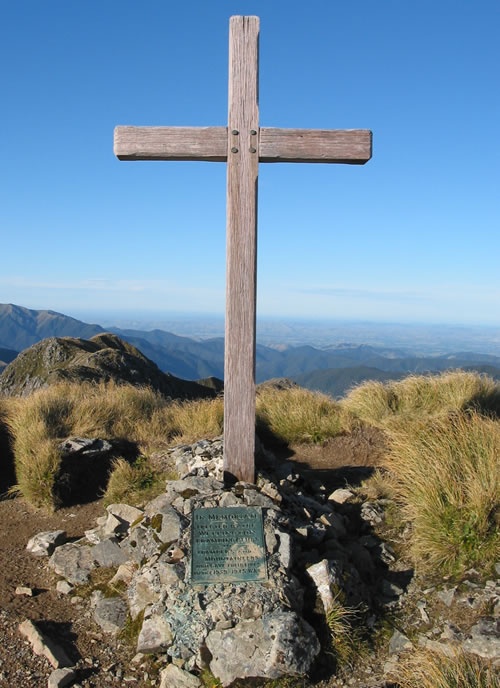Webpage header False Spur, Behives and Hector from Alpha. Photo- by Trippy Tramping
The Southern Crossing is one of the four classic tramping routes of the Tararua Range. The route has a long history, dating back to the early part of the twentieth century. Two Track Committees, one based in Otaki and the other in Greytown, wanted their respective regions connected by a track crossing the range via Mt Hector.
Through their efforts, the track was cut and three huts were erected, one near Otaki Forks, another at Alpha and the third in the Tauherenikau Valley. Later work in the 1920s by the newly formed Tararua Tramping Club saw further huts erected at Kime and Field.
Originally it was the route from Otaki Forks to the Wairarapa Plains and was called the Hector Track. (and in latter years, the Kaitoke roadend) popularised during the 1920s and 30s by the Tararua Tramping Club and other clubs in the Hutt Valley and Wairarapa.
The route can be traversed from either end, Otaki Forks or Kaitoke road ends. There are three main huts now. Field, Kime and Alpha. (Parawai Lodge at Otaki Forks can also be used, if needed. All huts are Standard huts and the usual hut fees for Standard huts apply. The middle section, from Table Top near Field hut, to Alpha hut at the eastern side traverses the open alpine tops of the Tararua range.
The highest point on the route is Mt Hector (1529 metres ASL) there is a large wooden cross and was erected by combined tramping clubs to commemorate mountaineers and other climbers killed in the Second World War.

By Chris Maclean, Tararua: the story of a mountain range
“In October 1949, it was agreed to erect an 8-foot wooden cross, of jarrah or totara, on the summit of Hector. During the weekend of 10-12 March 1950, a large working party drawn from all the clubs toiled up from Otaki Forks in typically atrocious Tararua weather carrying the cross (which weighed more than 200 pounds), the plaque, cement and gravel from the river. On the exposed tops there was so much wind and rain that only the cross bearers ventured beyond Kime, and it took all their stamina to carry it up the final stretch. The following weekend a smaller party returned to erect the cross and put the plaque in place. In June the memorial was dedicated. A fleet of three trucks full of Wellington trampers, a line of private cars and a contingent from Palmerston North converged on Otaki Forks. Once again the weather was bad and, as a result, the dedication service was held not on the summit but in Kime Hut. The Reverend R. McKenzie officiated. After the service, however, about twenty people continued on to Hector and as they gathered there to dedicate the cross the weather cleared. On the party was Bert Hines who later wrote: “The rugged cross and rainswept mountain top combined to revive memories of the good chaps we will see no more, and made us think the silent prayer, ‘Rest in Peace’”.”
Caution
The alpine tops of the Tararua range are notorious for exposure to extremes of weather conditions and gale winds that can occur at any time of the year. There have been a number of tramping fatalities on the route due to the extremes of Tararua weather and little opportunity to escape the conditions if caught out between the huts. Only those experienced in the Tararua conditions should attempt the crossing, or accompany a leader that has that experience. Gear taken should allow for extreme changes in weather conditions and a good level of fitness is needed.
For the last 31 years the Tararua Mountain Race held over the Southern Crossing has been held, with the fastest time being recorded of under four and half hours. But for more normal trampers, the 35 km tramp usually takes two or three days.
Click here to view the MSC Plan My Walk wideo on the Sounthern Crossing
There are several descriptions of the Southern Crossing found on the internet. below is the Tararua tramping Club guide to the Southern Crossing




